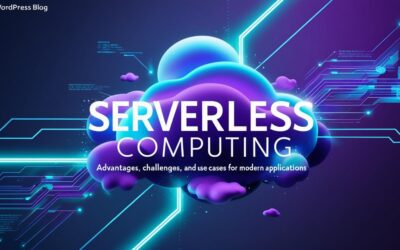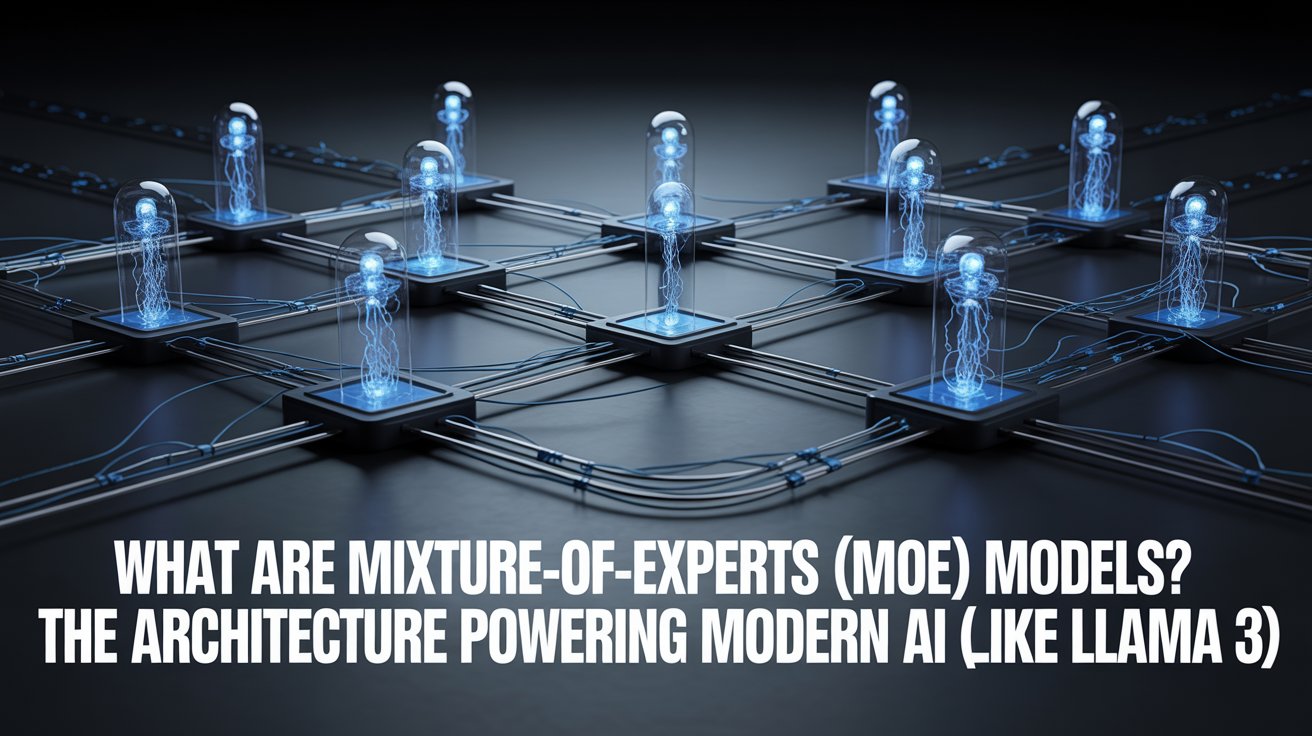If you’ve been following the latest advancements in artificial intelligence, you’ve likely heard names like Llama 3, Mixtral, or DeepSeek. What you may not know is that many of these cutting-edge models share a powerful underlying architecture called Mixture-of-Experts (MoE). This design is pivotal for creating the highly capable, yet efficient, large language models (LLMs) that are shaping the future of AI.
In this article, we’ll dive into what MoE models are, how they work, their profound advantages, the challenges they present, and why they are fundamental to the AI tools of tomorrow.
What Is a Mixture-of-Experts (MoE) Model?
At its core, a Mixture-of-Experts (MoE) is a machine learning technique where multiple specialized sub-networks, known as “experts,” work together within a single larger model . A gating network, or “router,” dynamically decides which expert or group of experts is best suited to process a given piece of input data .
This approach is a departure from traditional “dense” models, where the entire network is activated for every single input. Instead, MoE models use conditional computation, activating only a small subset of experts for each token (a piece of text, like a word) . This allows MoE models to dramatically scale up in size—reaching trillions of parameters—without a proportional increase in computational cost .
The concept isn’t entirely new; its roots trace back to a 1991 research paper . However, it has found its killer application in modern large language models, enabling the development of more powerful AI that is also more practical to train and run.
How MoE Architectures Work: Gating Networks and Expert Layers
To understand how MoE models achieve their efficiency, it helps to look at how they are built, typically within a Transformer architecture.
The Two Key Components
- Sparse MoE Layers: In a standard Transformer, dense feed-forward network (FFN) layers process all tokens. In an MoE model, these are replaced with sparse MoE layers. Each of these layers contains multiple experts—often hundreds or even thousands . Each expert is itself a neural network, usually an FFN .
- The Gating Network (Router): This is the traffic controller of the model. For each token, the router analyzes it and decides which experts are most relevant. It outputs a set of weights, selecting the top-k experts (e.g., the top 1 or 2) to process that token .
The Routing Process
A common and effective routing strategy is Noisy Top-k Gating . Here’s a simplified breakdown of the process:
- The router calculates a score for each expert based on the input token.
- It adds tunable noise to the scores. This helps with load balancing by ensuring all experts get a chance to be selected and trained .
- It then selects only the experts with the top-k scores.
- The outputs of these selected experts are combined based on their respective scores and passed to the next layer .
This process happens at every MoE layer in the model, meaning a token can be routed to different experts as it moves through the network’s layers.
Balancing the Load
One of the classic challenges in training MoE models is load balancing. Without intervention, the router might consistently favor a few strong experts, leaving others underutilized and undertrained . To prevent this, engineers use techniques like auxiliary loss functions, which penalize the model for uneven expert usage and encourage a more balanced distribution of tokens .
Key Advantages of MoE Models
MoE models offer several compelling benefits that make them ideal for scaling AI systems.
- Unmatched Computational Efficiency: By activating only a fraction of its total parameters per token (e.g., 2 out of 128 experts), an MoE model can achieve the inference speed of a much smaller dense model while having access to a vastly larger pool of knowledge . For instance, Mistral’s Mixtral 8x7B model uses only about 12.9B active parameters per token but has access to a total of 46.7B parameters, allowing it to outperform the much larger Llama 2 70B model .
- Scalability to Trillions of Parameters: MoE is the key architecture behind the largest AI models. Google’s Switch Transformer used an MoE design to scale to over 1 trillion parameters, achieving a 7x pre-training speedup compared to its dense counterpart . This scalability is crucial for continuing to improve model performance.
- Enhanced Specialization and Performance: Each expert in the network can learn to specialize in specific types of data, patterns, or linguistic features . This “divide and conquer” strategy often leads to better overall performance on complex, heterogeneous tasks compared to a generalist dense model.
- Cost-Effective Training and Inference: The reduced computational load translates directly into lower costs for training and running these massive models, making advanced AI more accessible .
Challenges and Considerations
Despite their advantages, MoE models are not without their own set of challenges.
- High Memory Demands: While MoEs reduce computational costs (FLOPs), all experts must still be loaded into memory (VRAM) during inference. This creates significant memory pressure, often requiring high-end hardware . A model like Mixtral 8x7B, with ~47B total parameters, requires enough VRAM to hold a dense model of that size, even though it only uses a fraction of the compute .
- Training Complexity: Ensuring stable training and balanced expert utilization requires careful tuning. Techniques like auxiliary losses are necessary but add complexity to the training recipe .
- Potential for Inference Latency: The routing logic and the need to communicate between different experts can sometimes introduce slight latency, although this is often offset by the massive gains in efficiency .
- Model Interpretability: With dynamic, token-wise routing, it can be more difficult to trace why a model made a specific decision, making MoE models somewhat less interpretable than dense models .
Real-World MoE Models and Examples
MoE is not just a theoretical concept; it’s powering some of the most prominent AI models available today.
- Mixtral 8x7B (by Mistral AI): A top-performing open-source model that uses 8 experts per layer, with 2 experts active per token (top-2 routing) . It demonstrates how MoE can create highly capable models that are efficient to run.
- Switch Transformer (by Google): A landmark model that scaled MoE to a trillion parameters by using a simple but effective top-1 (“switch”) routing strategy .
- Llama 3 and MoE: Researchers from the University of Texas at Austin and NVIDIA demonstrated an “upcycling” method to convert a pre-trained dense Llama 3-8B model into a high-performing 8-Expert MoE model using less than 1% of the compute typically required for pre-training from scratch . This shows how MoE can be leveraged to efficiently boost existing models.
- 2025’s Leading MoEs: The landscape continues to evolve rapidly. Models like DeepSeek-R1 (671B parameters, 9 active experts) and Qwen3-235B-A22B (235B parameters, 8 active experts) are pushing the boundaries of how many experts can be effectively used, employing advanced routing strategies for finer specialization .
The Future of MoE in AI
The development of Mixture-of-Experts models is far from over. Research is actively focused on:
- Optimizing Routing Mechanisms: New gating functions, like sigmoid-based routing as seen in DeepSeek-V3, are being explored to reduce competition between experts and stabilize training .
- Improving Hardware Compatibility: Making MoEs run efficiently on standard hardware is key to wider adoption .
- Hybrid Architectures: Combining MoE layers with dense layers to better balance efficiency and generalization .
- Advanced Quantization: Techniques like FP4 and INT4 quantization are crucial for reducing the memory footprint of these massive models, making them more deployable in real-world scenarios .
Conclusion
The Mixture-of-Experts architecture represents a fundamental leap in how we build and scale artificial intelligence. By moving beyond the one-size-fits-all approach of dense models, MoE allows for the creation of larger, more specialized, and incredibly efficient AI systems. As we’ve seen with models like Mixtral, Llama 3, and the latest from 2025, MoE is not a niche research topic but a core technology powering the modern AI revolution. While challenges around memory and training complexity remain, the ongoing innovation in this field promises a future where AI is both more powerful and more accessible to all.
Sources and References
- Datacamp. “What Is Mixture of Experts (MoE)? How It Works, Use Cases & More.” https://www.datacamp.com/blog/mixture-of-experts-moe
- Hugging Face. “Mixture of Experts Explained.” https://huggingface.co/blog/moe
- Synced Review. “Llama 3 Meets MoE: Pioneering Low-Cost High-Performance AI.” https://syncedreview.com/2024/12/28/self-evolving-prompts-redefining-ai-alignment-with-deepmind-chicago-us-eva-framework-18/
- Mu, S., & Lin, S. (2025). A Comprehensive Survey of Mixture-of-Experts: Algorithms, Theory, and Applications. arXiv. https://arxiv.org/abs/2503.07137
- IBM. “What is mixture of experts?” https://www.ibm.com/think/topics/mixture-of-experts
- DataScientest. “Mixture of Experts (MoE): The approach that could shape the future of AI.” https://datascientest.com/en/all-about-mixture-of-experts
- FriendliAI. “Comparing 2025’s Leading Mixture-of-Experts AI Models.” https://friendli.ai/blog/moe-models-comparison
- Deepchecks. “Exploring MoE in LLMs: Cutting Costs and Boosting Performance with Expert Network.” https://www.deepchecks.com/moe-llms-cost-efficiency-performance-expert-network/
- LinkedIn. “What’s new in Mixture of Experts in 2025?” https://www.linkedin.com/pulse/whats-new-mixture-experts-2025-upp-technology-jpw2c
- Google. “Switch Transformers: Scaling to Trillion Parameter Models with Simple and Efficient Sparsity.” (Cited in multiple sources, including and )
















